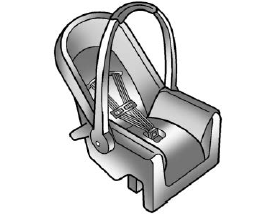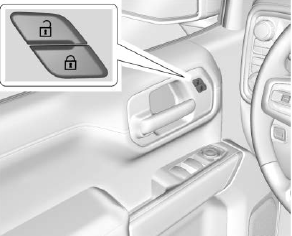Chevrolet Silverado: Child Restraints / Child Restraint Systems

Rear-Facing Infant Restraint
A rear-facing child restraint provides restraint with the seating surface against the back of the infant.
The harness system holds the infant in place and, in a crash, acts to keep the infant positioned in the restraint.

Forward-Facing Child Restraint
A forward-facing child restraint provides restraint for the child's body with the harness.

Booster Seats
A belt-positioning booster seat is used for children who have outgrown their forward-facing child restraint. Boosters are designed to improve the fit of the vehicle's seat belt system until the child is large enough for the vehicle seat belts to fit properly without a booster seat. See the seat belt fit test in Older Children.
Securing an Add-On Child Restraint in the Vehicle
Warning
A child can be seriously injured or killed in a crash if the child restraint is not properly secured in the vehicle. Secure the child restraint properly in the vehicle using the vehicle seat belt or LATCH system, following the instructions that came with that child restraint and the instructions in this manual.
To help reduce the chance of injury, the child restraint must be secured in the vehicle. Child restraints must be secured in vehicle seats by lap belts or the lap belt portion of a lap-shoulder belt, or by the LATCH system. See Lower Anchors and Tethers for Children (LATCH System) for more information. Children can be endangered in a crash if the child restraint is not properly secured in the vehicle.
When securing an add-on child restraint, refer to the following:
- Instruction labels provided on the child restraint
- Instruction manual provided with the child restraint
- This vehicle owner's manual
The child restraint instructions are important, so if they are not available, obtain a replacement copy from the manufacturer.
Keep in mind that an unsecured child restraint can move around in a collision or sudden stop and injure people in the vehicle. Be sure to properly secure any child restraint in the vehicle - even when no child is in it.
In some areas Certified Child Passenger Safety Technicians (CPSTs) are available to inspect and demonstrate how to correctly use and install child restraints. In the U.S., refer to the National Highway Traffic Safety Administration (NHTSA) website to locate the nearest child safety seat inspection station. For CPST availability in Canada, check with Transport Canada or the Provincial Ministry of Transportation office.
Securing the Child Within the Child Restraint
Warning
A child can be seriously injured or killed in a crash if the child is not properly secured in the child restraint. Secure the child properly following the instructions that came with that child restraint.
 Infants and Young Children
Infants and Young Children
Everyone in a vehicle needs protection! This includes infants and all other children.
Neither the distance traveled nor the age and size of the traveler changes the need,
for everyone, to use safety restraints...
 Where to Put the Restraint
Where to Put the Restraint
According to accident statistics, children and infants are safer when properly
restrained in an appropriate child restraint secured in a rear seating position...
Other information:
Chevrolet Silverado 2019-2025 Owners Manual: Instrument Panel Fuse Block (Right)
The right instrument panel fuse block access door is on the passenger side edge of the instrument panel. Pull off the cover to access the front of the fuse block. To access the back of the fuse block: Push the tab at the top of fuse block down...
Chevrolet Silverado 2019-2025 Owners Manual: Instrument Cluster
1500 Series Base Cluster English Shown, 2500/3500 Series and Metric Similar Midlevel Cluster English Shown, Metric Similar 1500 Series Uplevel Cluster English Standard Shown, 2500/3500 Series and Metric Similar Cluster Menu (Midlevel and Uplevel) There is an interactive display area in the center of the instrument cluster...
Categories
- Manuals Home
- 4th Generation Silverado Owners Manual
- 4th Generation Silverado Service Manual
- Driver Information Center (DIC) (Base Level)
- Tire Chains
- Power Outlets
- New on site
- Most important about car
Power Door Locks

If equipped with power door locks.
 : Press to lock the doors.
: Press to lock the doors.
